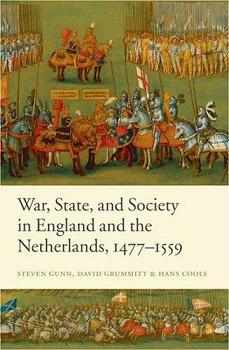
War, State and Society in England and the Netherlands, 1477-1559
Steven Gunn, David Grummitt & Hans Cools
395 pages including index
published in 2007
Everything the authors tried to achieve with this book is in the title, but whether they succeeded is another question. Based on a massive research project that was carried out between 1999 and 2002, what the book was intended to be was a comparative study of two roughly similar countries in a period critical to Early Modern European history, to determine the impact of war both on society and the (semi-modern) state. As the authors argue, both England and the Netherlands (meaning what we would now call the Low Countries) were sort of outliers in Europe, neither quite fitting in "conventional narratives of the growth of state power", not as centralised as other countries and with a greater level of democracy. For English historians, an added advantage of this comparison is that it puts England back into an European context by showing the simularities and differences between the two countries' experiences.
War, State and Society in England and the Netherlands, 1477-1559 is impressive and interesting but what it lacks is that comparative aspect that the title and introduction promises. It's more a parallel than a comparative history, with developments in the two countries looked at side by side. So you'd have a section on the defence of towns looking first at how English towns dealt with fortifications, then at how Dutch towns did the same, but nothing much on how they differed or why they did. This lack of analysis wasn't that big a problem for me personally because I found the subject interesting enough already.
To be honest, I wouldn't have minded had this been concerned only about the Netherlands, as this particular period is just so much more interesting in Dutch/Belgian history than it is in English history, what with those boring Tudors and all. At the start of the period the Netherlands are still very much a collection of countries under the shadow of Burgundy; at the end of the period it's unified under the Hapsburgs, mostly during the reign of Charles V. Yet the Netherlands remained a patchwork of principalities and overlapping loyalties with counts, provinces and even cities making their own policies, like Holland sending naval forces to the Baltic to protect its trade there on several occasions, with no regard for wider Hapsburg concerns...
War, State and Society in England and the Netherlands, 1477-1559 is divided in five parts, with a short introduction and shorter conclusion making two parts and the heft of the book being the three middle parts: towns at war, nobles at war and subjects at war. Each is build up in roughly the same way, with an introduction, at look at the resources towns, nobles or subjects have to bring to war, moving on to how each groups experiences war, how war influences each group's identity and finally a short conclusion/summing up. It's all written very well and concisely, with plenty of interesting examples and anecdotes. Despite three authors, there are no real differences in the writing styles between the chapters. As said, each part and each section and subsection in each part deals with both the English and the Dutch experiences; for the most part the Netherlands sections are richer in detail and more interesting.
This book is worth reading just for those details, for the portrait it sketches of an interesting period in Netherlands history, and to a lesser extent, in English history. It doesn't quite live up to its title, but it's worthwhile nonetheless.
Webpage created 15-01-2012, last updated 21-01-2012.